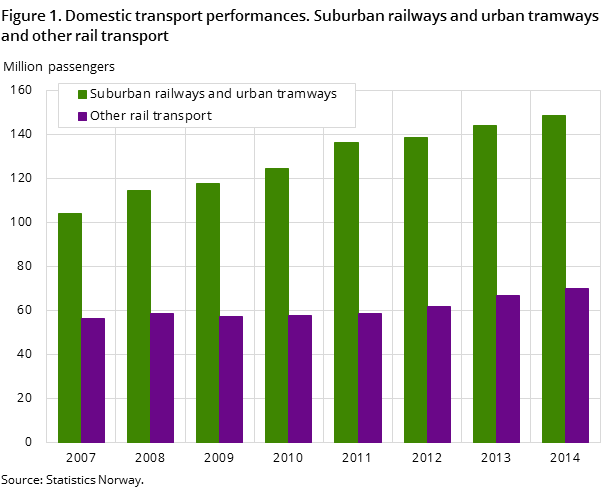Content
Published:
This is an archived release.
Rail passenger transport still on track
Almost 219 million passengers travelled by rail in 2014. This was an increase of 8 million passengers from 2013; an increase of 8 per cent.
| 2013 | 2014 | Per cent | ||
|---|---|---|---|---|
| 2013 - 2014 | 2010 - 2014 | |||
| 1Including only passengers who enter as well as leave any means of transport in Norway. | ||||
| 2Including only goods which are loaded as well as unloaded in Norway. | ||||
| 3The data source for scheduled road transport (buses and coaches) has been changed as from 2010. This cause a brake in the time series (see “About the statistics” for supplementary comments). | ||||
| 4The figures for water transport are preliminary for 2014 (see "open and read" at the bottom of the article). | ||||
| Passengers (million) | ||||
| Total | 5 317 | 5 474 | 3.0 | 8.5 |
| Water transport | 52 | 52 | 0.0 | 6.1 |
| Railway transport etc. | 211 | 219 | 3.8 | 19.7 |
| Road transport | 5 043 | 5 193 | 3.0 | 8.1 |
| Air transport | 11 | 11 | 0.0 | 0.0 |
| Million tonnes carried | ||||
| Total | 489 | 507 | 3.7 | 4.5 |
| Transport mainland, total | 381 | 403 | 5.8 | 9.2 |
| Water transport | 88 | 88 | 0.0 | 6.0 |
| Railway transport | 10 | 9 | -10.0 | 28.6 |
| Road transport | 284 | 306 | 7.7 | 9.7 |
| Air transport | 0 | 0 | ||
| Transport Norwegian continental shelf - mainland, total | 108 | 104 | -3.7 | -10.3 |

In recent years, the number of passengers travelling by rail has increased. In the period 2012-2014, the increase was 18 million passenger journeys, and in the 5-year period 2009-2014, slightly above 43 million (25 per cent). Suburban railways and urban tramways accounted for 56 and 71 per cent of the growth in these periods respectively. The railway accounted for the rest. Traffic with tramways and suburban railways is characterised by short trips. In 2014, the average journey length per passenger was barely 5.1 kilometres. The corresponding figure for the railroad was 48.6 kilometres.
Based on the number of journeys, the suburban railways and urban tramways dominated the rail traffic with a share of 66 per cent in 2014. Based on transport work, the opposite is true. Traffic by railroad accounted for almost 82 per cent of passenger kilometres by rail in 2014, or 3.4 billion. Although this was an increase of 5.7 per cent from the previous year, the passenger transport work by railroad accounted for only 5.5 per cent of the transport work done by private cars in 2014.
The strongest growth in traffic by private cars since 2006
A total of 61.2 billion passenger kilometres was performed by private cars in 2014, and the number of journeys came to 4.5 billion. This was an increase in both measurements of 3.2 per cent compared to 2013, and represented the strongest increase in the transport work by private cars since 2006. This year the increase in the transport work was also 3.2 per cent, while the increase in journeys was 1.7 per cent compared to the previous year.
The growth in passenger traffic by private car still resulted in a marginal increase in the proportion of private car use versus all forms of transport. The car accounted for 78 per cent of the transport work and roughly 82 per cent of all passenger trips in 2014.
50 per cent growth in the transport work with rental cars
The use of rental cars is still limited. They accounted for 1.7 billion passenger kilometres in 2014, or just a third of the transport work by air. However, the demand for rental cars is growing rapidly. Compared with 2013, the growth in the transport work was 6.4 per cent, while the growth in the last 5-year period (2009-2014) was 50 per cent
Continued growth for lorries
The financial crisis resulted in a decline for the truck industry by 8 per cent in 2009, measured in tonnes-kilometres. Demand for freight transport by road increased in 2010, levelling off in 2011 before new growth in the period 2012-2014. In the five-year period 2009-2014, the transport work with goods vehicles increased by 23 per cent to almost 19.9 billion tonnes-kilometres. The equivalent growth from 2013 to 2014 was almost 4 per cent. The number of tonnes transported increased by almost 8 per cent in 2014 to 306 million. The average length per tonne transported decreased by 2.6 kilometres from 2013 to 2014.
Vessels for hire or reward and on own account and ferry transportOpen and readClose
The statistical basis for vessels for hire or reward and on own account is partially calculated. The basis of calculation has gradually become more uncertain. The same goes for the goods (the weight of the vehicles) on the car ferries. A thorough review will be done in autumn 2015. For the time being, the published figures for 2013 are kept as preliminary for 2014.
Contact
-
Geir Martin Pilskog
E-mail: geir.martin.pilskog@ssb.no
tel.: (+47) 40 81 13 83
